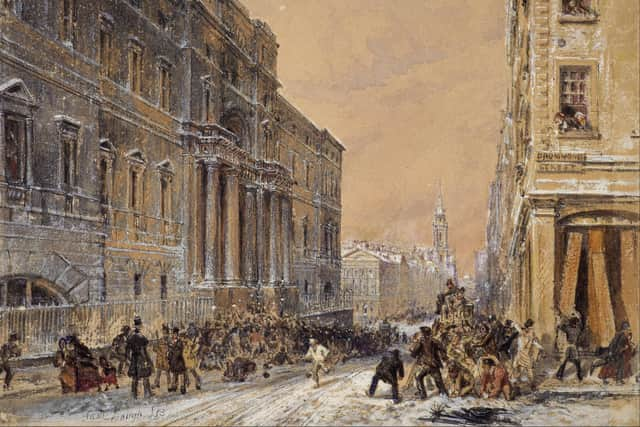This Edinburgh students’ snowball fight ended with the army being sent in
For two days in 1838, the peace of the city was described as having been “seriously disturbed”, by the “riotous and disorderly proceedings” of a large number of Edinburgh University students, who had started a snowball fight.
The disturbance broke out on the afternoon of Thursday, January 11 in front of the Old College at South Bridge, when a band of students and local tradesmen began launching snowballs at one another.
Advertisement
Hide AdAdvertisement
Hide AdHowever, what began in “a spirit of harmless amusement”, quickly descended into outright chaos and violence.
The Scotsman reported that, unfulfilled by their small-scale skirmish, the students proceeded to attack passersby and maliciously started to smash tenement windows on the opposite side of the street.
Within minutes, the police arrived to quell the ugly scenes and detain the students, who agreed in unison to an immediate ceasefire.


But the students’ pledge for tranquillity did not last long. Instead, it only got worse, the students resuming the fighting with real weapons and rocks concealed in their snowballs.
"No sooner were the prisoners released,” reported The Scotsman, “than they to the amount of about 300, met in the quadrangle of the College, and came to a resolution to renew the disturbances on the following day, and to arm themselves with bludgeons and other weapons for the occasion."
The students assembled once more outside the Old College on the Friday, and this time their assault was launched with even more ferocity.
Barricading themselves behind the university gates, they “sent forth an almost unintermitting shower of snow-balls – frequently with stones in the heart of them – for hours together, breaking an immense number of panes of glass in the windows on the opposite side, and severely wounding passengers.”
The intensity of the almighty stramash resulted in all of the local shops putting up their shutters, and, at around 3pm, the police again arrived, this time in considerable force, and made attempts to burst open the university gates and disperse the rioters. Officers managed to capture 37 of the students and dragged them to the station.
Advertisement
Hide AdAdvertisement
Hide AdAt around 3.30pm, the Lord Provost and Magistrates appeared and unsuccessfully appeared to the remaining students to end the riot that had ensued.
When the students refused, the Lord Provost sent in the military. The Scotsman reported: "His Lordship drove up to the Castle and brought down a detachment of the 79th regiment, with muskets and fixed bayonets, who soon took the College by storm, and somewhat cooled the courage of the assailants.
“As evening came on, the crowd gradually dispersed, and the military then retired to the Castle”.
Small pockets of fighting continued in the streets until the late evening, with a number of people injured and windows broken around South Bridge, however no other serious disturbance took place and the situation was soon brought under control.
In the aftermath of the snowball chaos, it was reported that the students had agreed a fighting fund among themselves, to remunerate those fined by the Magistrates in court.
A message from the Editor:
Thank you for reading this article. We're more reliant on your support than ever as the shift in consumer habits brought about by coronavirus impacts our advertisers.
If you haven't already, please consider supporting our trusted, fact-checked journalism by taking out a digital subscription at https://www.edinburghnews.scotsman.com/subscriptions.
Comments
Want to join the conversation? Please or to comment on this article.
